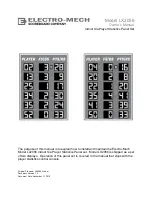
2 Prevention of Electro Static Discharge (ESD) to
Electrostatically Sensitive (ES) Devices
Some semiconductor (solid state) devices can be damaged easily by static electricity. Such components commonly are called
Electrostatically Sensitive (ES) Devices. Examples of typical ES devices are integrated circuits and some field-effect transistors and
semiconductor "chip" components. The following techniques should be used to help reduce the incidence of component damage
caused by electro static discharge (ESD).
1. Immediately before handling any semiconductor component or semiconductor-equipped assembly, drain off any ESD on your
body by touching a known earth ground. Alternatively, obtain and wear a commercially available discharging ESD wrist strap,
which should be removed for potential shock reasons prior to applying power to the unit under test.
2. After removing an electrical assembly equipped with ES devices, place the assembly on a conductive surface such as alminum
foil, to prevent electrostatic charge buildup or exposure of the assembly.
3. Use only a grounded-tip soldering iron to solder or unsolder ES devices.
4. Use only an anti-static solder removal device. Some solder removal devices not classified as "anti-static (ESD protected)" can
generate electrical charge sufficient to damage ES devices.
5. Do not use freon-propelled chemicals. These can generate electrical charges sufficient to damage ES devices.
6. Do not remove a replacement ES device from its protective package until immediately before you are ready to install it. (Most
replacement ES devices are packaged with leads electrically shorted together by conductive foam, alminum foil or comparable
conductive material).
7. Immediately before removing the protective material from the leads of a replacement ES device, touch the protective material
to the chassis or circuit assembly into which the device will be installed.
Caution
Be sure no power is applied to the chassis or circuit, and observe all other safety precautions.
8. Minimize bodily motions when handling unpackaged replacement ES devices. (Otherwise hamless motion such as the brushing
together of your clothes fabric or the lifting of your foot from a carpeted floor can generate static electricity (ESD) sufficient to
damage an ES device).
5
Summary of Contents for 42WP16A
Page 7: ...4 Service Hint 7 ...
Page 8: ...5 Location of Lead Wiring 8 ...
Page 31: ...10 IC Block Diagram 31 ...
Page 32: ...INPUTA A 32 ...
Page 33: ...11 Conductor Views 11 1 F Board A B C D E F G H I 1 2 3 4 5 6 F F BOARD TXN F1JASE 33 ...
Page 34: ...11 2 P1 Board A B C D E F G H I 1 2 3 4 5 6 P1 BOARD FOIL SIDE TXNP11JASE 34 ...
Page 36: ...A B C D E F G H I 1 2 3 4 5 6 P1 BOARD COMPONENT SIDE TXNP11JASE 36 ...
Page 58: ...58 ...
Page 59: ...13 Mechanical Parts Location 103 ...
Page 60: ...104 ...
Page 62: ...15 Replacement Parts List 15 1 Relpacement Parts List Notes 106 ...
Page 87: ...12 4 P1 Board Schematic Diagrams 62 ...
Page 88: ...12 5 F and P3 Board Schematic Diagram 63 ...
Page 89: ...12 6 P5 P6 P7 and P8 Board Schematic diagram 64 ...
Page 91: ...12 8 HX Board Schematic Diagrams TZTNP01KNSR 66 ...
Page 93: ...12 10 HZ Board 1 2 Option RTB421 Schematic Diagram TXNHZ10JJS 68 ...
Page 94: ...12 11 HZ Board 2 2 Option RTB421 Schematic Diagram TXNHZ10JJS 69 ...
Page 96: ...12 13 J Board 1 5 Schematic Diagrams TXN J10JAS 71 ...
Page 97: ...12 14 J Board 2 5 Schematic Diagrams TXN J10JAS 72 ...
Page 98: ...12 15 J Board 3 5 and H3 Board Schematic Diagrams TXN J10JAS 73 ...
Page 99: ...12 16 J Board 4 5 Schematic Diagrams TXN J10JAS 74 ...
Page 100: ...12 17 J Board 5 5 Schematic Diagrams TXN J10JAS 75 ...
Page 102: ...12 19 D Board 1 14 Schematic Diagrams TZTNP02KNSR others TZTNP01KNSC 42WP16C 77 ...
Page 103: ...12 20 D Board 2 14 Schematic Diagrams TZTNP02KNSR others TZTNP01KNSC 42WP16C 78 ...
Page 104: ...12 21 D Board 3 14 Schematic Diagrams TZTNP02KNSR others TZTNP01KNSC 42WP16C 79 ...
Page 105: ...12 22 D Board 4 14 Schematic Diagrams TZTNP02KNSR others TZTNP01KNSC 42WP16C 80 ...
Page 106: ...12 23 D Board 5 14 Schematic Diagrams TZTNP02KNSR others TZTNP01KNSC 42WP16C 81 ...
Page 107: ...12 24 D Board 6 14 Schematic Diagrams TZTNP02KNSR others TZTNP01KNSC 42WP16C 82 ...
Page 108: ...12 25 D Board 7 14 Schematic Diagrams TZTNP02KNSR others TZTNP01KNSC 42WP16C 83 ...
Page 109: ...12 26 D Board 8 14 Schematic Diagrams TZTNP02KNSR others TZTNP01KNSC 42WP16C 84 ...
Page 110: ...12 27 D Board 9 14 Schematic Diagrams TZTNP02KNSR others TZTNP01KNSC 42WP16C 85 ...
Page 111: ...12 28 D Board 10 14 Schematic Diagrams TZTNP02KNSR others TZTNP01KNSC 42WP16C 86 ...
Page 112: ...12 29 D Board 11 14 Schematic Diagrams TZTNP02KNSR others TZTNP01KNSC 42WP16C 87 ...
Page 113: ...12 30 D Board 12 14 Schematic Diagrams TZTNP02KNSR others TZTNP01KNSC 42WP16C 88 ...
Page 114: ...12 31 D Board 13 14 Schematic Diagrams TZTNP02KNSR others TZTNP01KNSC 42WP16C 89 ...
Page 115: ...12 32 D Board 14 14 Schematic Diagrams TZTNP02KNSR others TZTNP01KNSC 42WP16C 90 ...
Page 116: ...12 33 C1 Board Schematic Diagrams 91 ...
Page 117: ...12 34 C2 Board Schematic Diagrams 92 ...
Page 118: ...12 35 C3 Board and V1 Board Schematic Diagrams 93 ...
Page 119: ...12 36 C4 Board Schematic Diagrams 94 ...
Page 121: ...12 38 SC Board 1 2 Schematic Diagrams 96 ...
Page 122: ...12 39 SC Board 2 2 Schematic Diagrams 97 ...
Page 124: ...12 41 SU Board Schematic Diagrams 99 ...
Page 125: ...12 42 SD Board Schematic Diagrams 100 ...
Page 127: ...12 44 SS SS2 SS3 and S1 Board Schematic Diagrams 102 ...
Page 129: ......






































